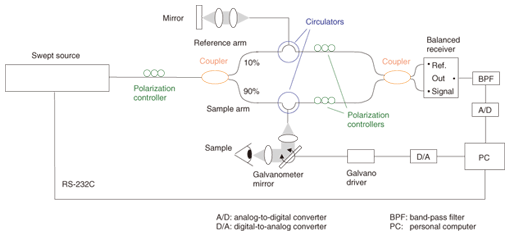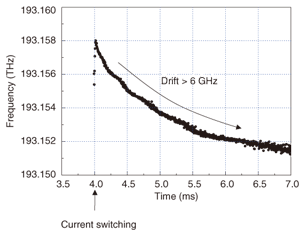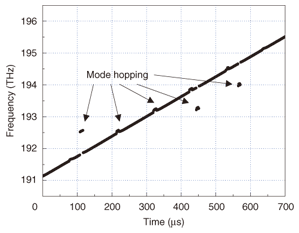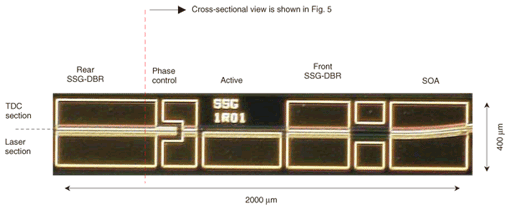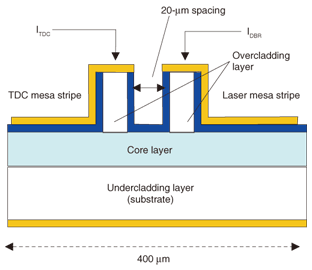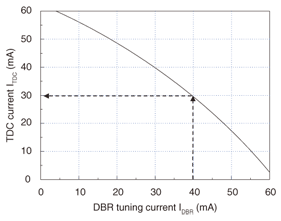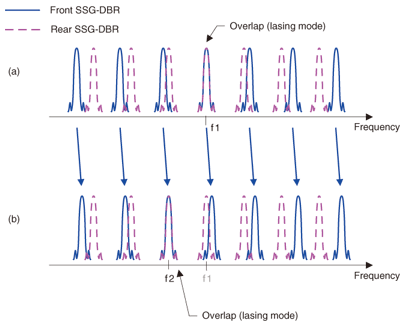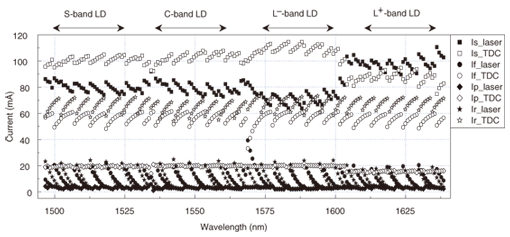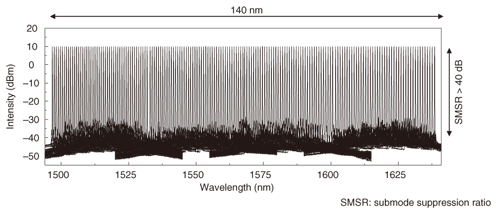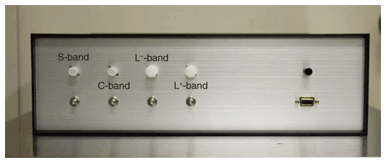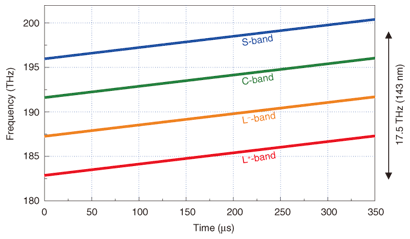 |
|||||||||||||||||||||
|
|
|||||||||||||||||||||
|
Special Feature: Light Source Technologies for Sensing Applications Vol. 7, No. 1, pp. 16–22, Jan. 2009. https://doi.org/10.53829/ntr200901sf3 143-nm Swept Source for OFDR-OCT Utilizing TDC-SSG-DBR LasersAbstractWe have made a single-mode, fast-frequency-swept light source for use in optical frequency domain reflectometry optical coherence tomography (OFDR-OCT) by utilizing superstructure-grating distributed Bragg reflector (SSG-DBR) lasers. A noteworthy feature of our laser is the use of a thermal drift compensator (TDC), which enables a fast and accurate frequency sweep. We fabricated TDC-SSG-DBR lasers operating at four different wavelengths covering four wavelength bands. Frequency tuning of 17.5 THz (143 nm) was achieved within 350 µs. A single-mode, wide, and fast wavelength sweep was demonstrated.
1. IntroductionWavelength-tunable lasers are attractive for various applications in, for example, photonic network systems and medical sensing systems that use optical coherence tomography (OCT). The mechanism and setup are described in section 2. For use as light sources in optical frequency domain reflectometry optical coherence tomography (OFDR-OCT) systems, tunable lasers require a wide wavelength tuning range and a fast wavelength sweep. A wide wavelength tuning range enhances the spatial resolution, and a high tuning speed improves the clarity of the OCT image, which is blurred because of movement by the human subject. In the work described here, we demonstrated a wide lasing-frequency sweep with superstructure-grating distributed Bragg reflector (SSG-DBR) lasers using a thermal drift compensator (TDC), which achieves a fast and accurate frequency sweep. We newly designed and fabricated TDC-SSG-DBR lasers operating in the S-, C-, L--, and L+-bands and greatly expanded the total tuning range to more than 140 nm. The SSG-DBR lasers cover the wavelength ranges of 1496–1532 nm (S-band laser), 1530–1567 nm (C-band laser), 1561–1601 nm (L--band laser), and 1601–1639 nm (L+-band laser). By expanding the tuning range from 35 to 143 nm, we can greatly improve the spatial resolution of the OCT image from 20 to 5 µm. This expands its possible applications. By installing the high-resolution swept source into a fiberscope OCT system, we should be able to discover smaller pathogens (e.g., cancers). We have demonstrated a rapid sweep with a frequency range of 17.5 THz (143 nm in wavelength) by simultaneously driving the four TDC-SSG-DBR lasers. 2. OCT and advantages of SSG-DBR laserOCT is a nondestructive and noninvasive monitoring technique, which was first demonstrated in the mid 1990s. By utilizing a near-infrared optical source, it can obtain a tomogram with a depth range of a few millimeters and a spatial resolution of several tens of micrometers. The high-resolution characteristics attracted the attention of medical researchers, and OCT has been actively studied in the medical sensing field. The near-infrared source used in OCT allows us to observe transparent organs of the human body, for example, the cornea and the iris. The setup used for OFDR-OCT measurement is shown in Fig. 1. The light from a swept source is split by an optical coupler into a sample beam (90%) and a reference beam (10%). The beams reflected from the sample and the mirror are combined by a coupler, and the interference signal is detected by a balanced receiver for all frequency channels. By applying a fast Fourier transform (FFT) to the sampled data, we can obtain the reflectivity distribution in the depth direction, namely an OCT image.
There are two main types of fast-sweep sources: the external cavity laser [1]–[4] and the monolithically integrated semiconductor laser. External cavity lasers offer a very fast wavelength sweep, so they provide unblurred OCT images. However, they operate in the multimode optical spectrum, so the measurement depth is limited because of their low coherency. In addition, these lasers sweep linearly in wavelength per unit time. Therefore, the linear wavelength characteristics require us to re-scale the sampled data to K-space data before applying an FFT. In contrast, monolithic semiconductor lasers provide single-mode operation, which offers increased measurement depth. We have developed a monolithically integrated semiconductor laser called an SSG-DBR laser [5], which offers an OCT observable depth range of more than 1 cm because of its high coherency. The other major advantage of our laser is that the lasing wavelength can be set to any value in the entire wavelength tuning range. This flexibility enables tuning with a constant frequency spacing (K-space linear tuning). When the sampling is performed with an even frequency step, we can directly apply an FFT to the data. An FFT greatly reduces the processing time and enhances the dynamic range of the OCT image. This laser has recently attracted attention as a medical sensing light source and is a candidate for use in OFDR-OCT [6]. 3. Problems with conventional DBR lasersThe frequency response time of the DBR laser is estimated to be several nanoseconds, and the time is electrically determined by the lifetime of injected carriers. However, there is an unintentional wavelength drift caused by the thermal drift that results from tuning current injection (Joule heating). The dynamic frequency change that occurred when the tuning current was changed is shown in Fig. 2. The lasing frequency drifted more than 6 GHz, and it generally took a few seconds for the lasing wavelength to stabilize. The results of a fast frequency sweep with a conventional SSG-DBR laser are shown in Fig. 3. It reveals a large frequency deviation and a considerable amount of mode hopping, which are not permissible in OCT.
In the present work, we introduced a TDC mesa structure [7] monolithically integrated parallel to the mesa stripe of an SSG-DBR laser [8], [9]. This new laser can have a shorter wavelength transient time when the tuning current is changed. 4. Laser structure and tuning method4.1 Laser structureA photograph of our TDC-SSG-DBR laser is shown in Fig. 4. The laser consists of a semiconductor optical amplifier (SOA) region, front SSG-DBR region, active region, phase control region, and rear SSG-DBR region. Their respective lengths are 400, 310, 350, 80, and 610 µm. The core layer of the active region and the SOA is an active multiple quantum well (MQW) layer, and the remaining regions consist of a passive bulk core layer. The active MQW layer and the passive bulk layer were optically connected with a butt-joint structure. The respective photoluminescence peaks of the active layers of the S-, C-, L--, and L+-band SSG-DBR lasers were 1515, 1550, 1585, and 1620 nm, and those of the passive layers were 1360, 1400, 1400, and 1470 nm.
A noteworthy feature of our new laser is that it has a TDC mesa stripe parallel to the laser mesa stripe with a spacing of 20 µm, as shown in Fig. 5. Here, I is the current injected into the mesa stripe, and the subscript indicates the laser or TDC section. When TDC current is injected, the TDC mesa stripe acts as an electrical heater. The basic idea behind our study was to investigate how to maintain the temperature of the optical waveguide. This means that we must keep the total electrical power injected into the two stripes constant. We describe the TDC method in detail in section 4.2 and the frequency setting in section 4.3.
4.2 Thermal drift compensation methodAs mentioned in the previous section, the goal of the TDC structure is to compensate for the Joule heat variation that results from changing the tuning current. To achieve this, if we increase the power to the laser stripe for tuning, we must provide compensation by reducing the power to the TDC stripe, and vice versa. When the total power is kept constant, the amount of generated Joule heat is also constant, and there is no thermal drift. This TDC method [8] is applied to the SOA, front SSG, phase, and rear SSG region. The individual powers and the TDC current are easily determined from the current-versus-power (I-P) curves, which have been measured previously. A current map for determining the TDC current, which was obtained from the I-P curves, is shown in Fig. 6. When we set the DBR current to 40 mA, the TDC current should be 30 mA, as shown Fig. 6.
4.3 Lasing frequency settingHere we describe the selection of the lasing mode in SSG-DBR lasers. The reflective spectra of the front and rear SSG-DBRs are shown in Fig. 7. The reflective spectrum of the SSG-DBR region has seven reflective peaks, and the spacing of these peaks is different for the front and rear SSG-DBR regions. Before the tuning current is injected, the center reflection peaks of the front and rear SSG-DBR regions overlap as shown in Fig. 7(a), and the lasing mode appears around f1. When the tuning current is injected into the front SSG-DBR regions, the reflective spectrum of the front SSG-DBR shifts to a higher frequency (plasma effect), and the lasing frequency hops to f2 (Vernier effect) [5], as shown in Fig. 7(b). Once the lasing frequency has been roughly tuned by using the Vernier effect, it can be finely adjusted by injecting a phase control current. Thus, the laser provides a wide tuning range of more than 4.3 THz (35 nm) if we inject tuning currents into the front SSG-DBR, rear SSG-DBR, and phase control region. As mentioned above, we can set the lasing frequency to any value over the entire tuning range.
As regards the role of the SOA, when the tuning currents are injected, the output power from the laser section decreases because the optical loss in each tuning region increases owing to the current injection. The SOA output power is boosted by injecting the SOA current, and it can be equalized for the entire tuning range. 4.4 Characteristics during static operationWhen operating the SSG-DBR lasers, we drove all the regions of the laser and TDC sections. The total electrical input powers for the SOA, front SSG-DBR, rear SSG-DBR, and phase control region were kept at 250, 70, 90, and 30 mW, respectively. The currents injected into the laser and TDC sections for all tuning regions are plotted in Fig. 8. It should be noted that the curves of the TDC currents are the reverse of that of the laser diode current. The TDC currents were accurately set to maintain the total power at a constant value. The superimposed spectra of the S-, C-, L--, and L+-band SSG-DBR lasers, which were measured during static operation, are shown in Fig. 9. We set the frequency grid of each laser to 43 or 44 channels with a frequency spacing of 100 GHz. A module output power of 10 dBm and stable operation with a submode suppression ratio of more than 40 dB were achieved for the entire tuning range.
4.5 Characteristics during dynamic operation (fast frequency sweep)We demonstrated a fast frequency sweep using the S-, C-, L--, and L+-band SSG-DBR laser modules. To drive these lasers synchronously and simultaneously, we fabricated the 4-channel SSG-DBR laser control unit shown in Fig. 10. This unit can store tuning current data of up to 2000 frequency channels for each laser, which enables a repeating frequency sweep.
We set the frequency grid number of each laser to 700 channels with a frequency interval of 6.25 GHz (≒ 0.05 nm). The total number of frequency channels was 2800 (700 channels × 4 lasers), and the total tuning range was greatly expanded to 17.5 THz (143 nm). The time interval for the frequency sweep was set to 500 ns/channel. We swept the frequencies of the four lasers simultaneously. The total time needed to scan all the channels was 350 µs. The dynamic change in the frequency was measured by the time-resolved spectrum method [8]. The sampling time of the digitizing oscilloscope was set to 100 ns. There were five sampling points for each frequency channel, and we plotted the fourth sampling point on a graph. Time-resolved spectra showing frequency data for 2800 points are plotted in Fig. 11. We achieved a rapid and accurate frequency sweep with a range of 17.5 THz (143 nm) without any mode hopping.
5. ConclusionWe have demonstrated a fast frequency sweep with a time interval of 500 ns/channel by synchronously operating S-, C-, L--, and L+-band SSG-DBR lasers equipped with TDCs. A total tuning range of 17.5 THz (143 nm) was achieved by sweeping 2800 frequency channels, and this provided a spatial resolution of 5 µm for OCT. A fast and accurate frequency sweep was achieved by suppressing thermal drift. SSG-DBR lasers with TDCs are suitable for use as fast-swept light sources and are expected to be applied to fiberscope OCT systems. References
|
|||||||||||||||||||||








